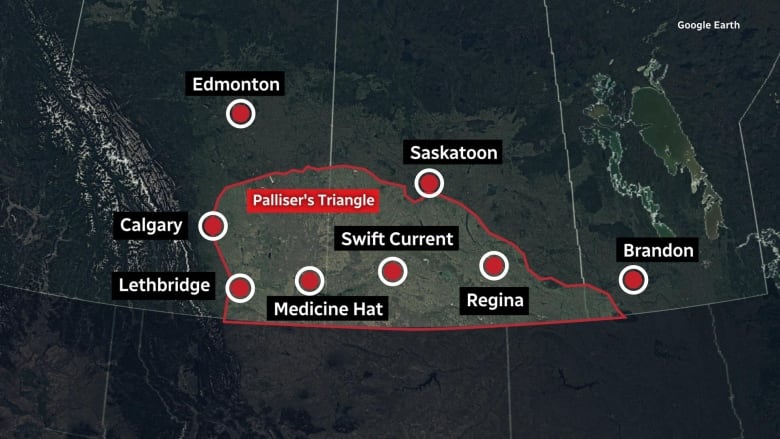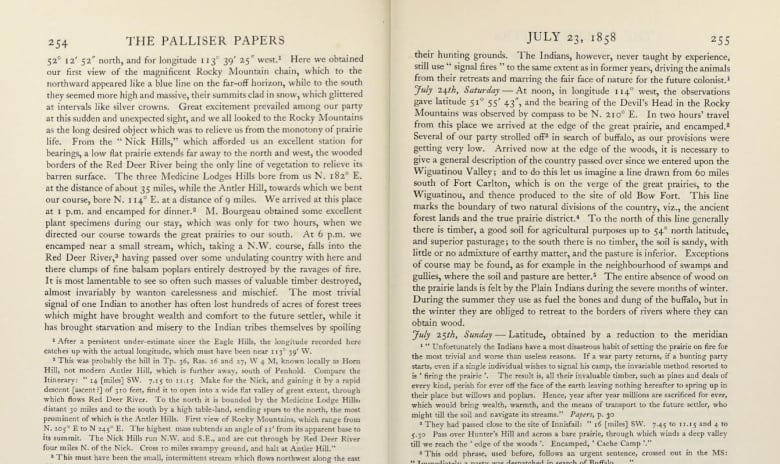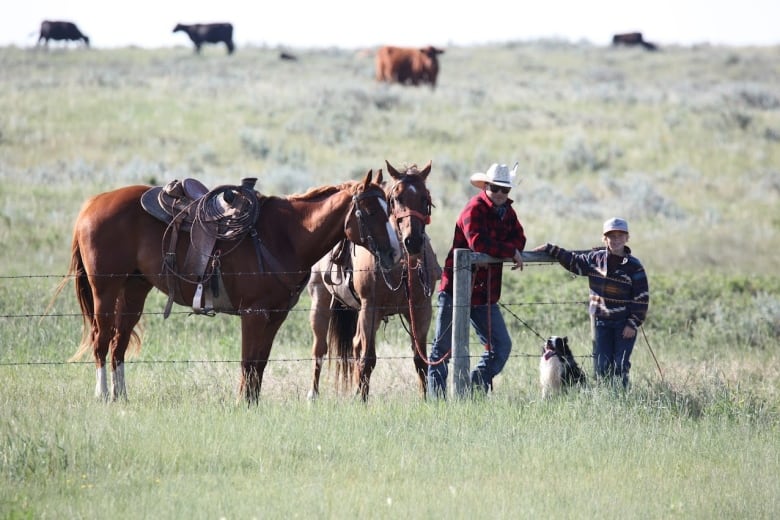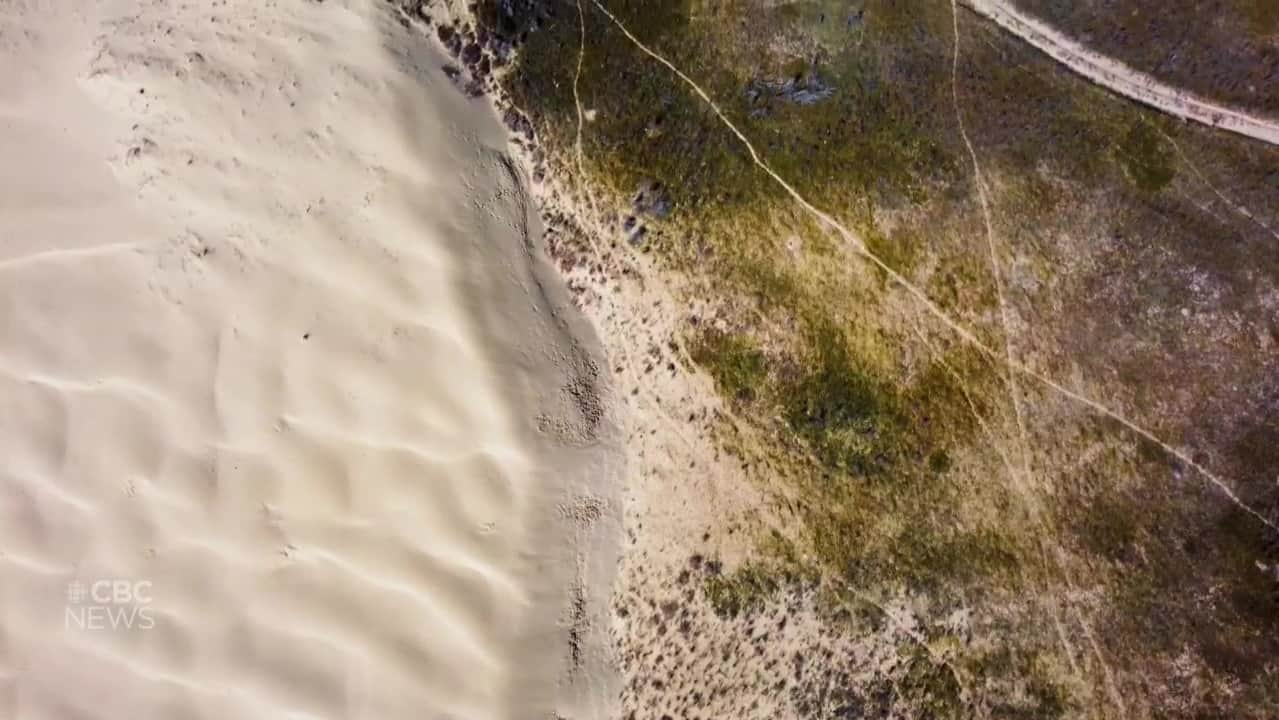CBC Alberta and Saskatchewan have teamed up for a series on weather and climate change on the Prairies. Meteorologist Christy Climenhaga will bring her expert voice to the conversation to help explain weather phenomena and climate change and how it impacts everyday life. As part of the series, we asked the CBC News audience for their ideas for stories that interested them. The history and the future of Palliser’s Triangle has been one of the most requested stories.
Sitting atop his weary stead, Capt. John Palliser gazed eastward across what would one day be known as Canada’s breadbasket.
The area of the southern Prairies is the traditional land of the Blackfoot Confederacy, including the Blood Tribe in southern Alberta.
What the Irish country gentleman-turned-expedition-leader saw in the region, known for the bison hunt, was anything but hopeful.
“The heat was very great while travelling through miles of burning sand,” Palliser would opine in an 1862 report that assessed western Canada’s agriculture and settlement future.
His travels were commissioned by the British government, and his report would have implications on the construction of the Canadian Pacific Railway in the southern Prairies.
A journal entry in The Palliser Papers report dated July 24, 1858, described the area as being flanked by “the ancient forest lands and the true prairie district” with timber and “good soil for agricultural purposes” and “superior pasturage.”

“To the south there is no timber, the soil is sandy, with little or no admixture or earthy matter and the pasture is inferior.”
Much of the arid country was “occupied by tracts of loose sand, which is constantly on the move before the prevailing winds.”
Surrounded by sand hills — “which had been all but impassable to the carts, and fearfully severe on the horses” — Palliser declared that the land around him would “forever be comparatively useless.”
He was talking about the expanse of prairie grassland in southeast Alberta, southern Saskatchewan and extreme southwest Manitoba, that today is known as Palliser’s Triangle.
Not exactly a glowing review.

So why was Palliser’s Triangle thought of as poor for farming and what of its future with ongoing climate change?
To better understand, we have to step back and look at the region in the late 19th century.
A different landscape
Stephen Wolfe, a research scientist with the Geological Survey of Canada, a part of Natural Resources Canada, reconstructed the landscape that Palliser would have encountered during his 1857-1860 expedition.
Palliser’s Prairies expedition was during a drought period, Wolfe says, but the drought wasn’t the only element that shaped his observations.
According to Wolfe, the path taken by Palliser did not include the entire southern Prairies.
Palliser’s survey was also influenced by travelling through the Elbow Sand Hills in Saskatchewan and the Middle Sand Hills in Alberta, a “central desert region” landscape that looked very different at that time.
“Sand dunes were far more active than they are today,” Wolfe says.
“They were more active than they were even during the Dirty ’30s.”
The 1930s got its infamous name thanks in part to the dust storms that ravaged the prairie landscape because of drought conditions and farming practices of the time.
And while we still have sand dunes in Alberta and Saskatchewan, Wolfe says going back as far as the 1700s, the region would have featured more open and more widespread sand areas and dunes.
“We literally can see fossil footprints of old sand dunes on the prairies and we can tell these were desert dunes that then became transformed into the dunes that we see today,” he says.
Wolfe says today dunes have been largely stabilized by vegetation.
“There are no desert-type dunes in Canada today. There are all these vegetated parabolic dunes, but the dunes that we dated were desert dunes.”
Palliser’s Triangle, once a near-desert but now supporting vast tracts of crops and livestock, has seen dramatic change over the past two centuries – and could see more transition as our climate changes.
So why is it so sandy?
There are a number of reasons for the desert dunes of the past, Wolfe said.
Canada’s prairie sand dunes are the result of glacial ice melt thousands of years ago, and those active dunes fields have been shrinking with our warming climate, albeit slowly.
Wolfe says that up until the 1700s, these dunes were, in fact, active because it was cold and dry: a shortened growing season and less moisture.
“The landscape doesn’t change immediately, it takes time, just like it takes time to melt a glacier. It takes time to stabilize sand dunes, and it took time to put vegetation onto the prairies to transform those dunes.”

The area is the traditional land of the Blackfoot Confederacy, and was sometimes called Blackfoot Nation. It’s arid landscape in the late 19th century was useful for bison hunting, which Wolfe says kept the dunes active.
“That [Elbow Sand Hills] was used extensively by Indigenous peoples to herd bison into the dunes to corral them,” he says.
“The bison were trampling over the dunes, that meant that there was a high level of disturbance.”
Today, Wolfe says most sand hill areas are used as dryland agriculture for cattle grazing with a lower population of cattle on the land.
According to Wolfe, the level of sand dune activity has reduced 100-fold, if not even 1,000-fold over what it was during its maximum period.
“We are seeing literally the extinction of sand hills, of active dunes on the prairies now.”

Sand hills today
Sand hill activity may be declining, but they are not gone, and they are not as useless as Palliser may have thought.
Erin McKnight and her family ranch cattle on the east side of the Great Sand Hills of Saskatchewan, and have done so for close to 30 years.
“It’s very rough terrain in certain areas. The sand hills, some of it is really nice and rolling. And then some of it is what we refer to as choppies or rough fields,” says McKnight.
McKnight says that some hills are up to 10 metres high, covered with sage and grasses, and full of wildlife. And pure sand dunes are scattered around the area as well. While they can’t grow crops on the sand hills, they have been able to keep around 550 cattle.

She says that there can be challenges with the area. It can be hard on equipment and it takes longer to move cattle around, and of course moisture levels are low.
“It’s dry here. It’s sand underneath us. So our grasses are different than they are in different areas of the province.”
She says with those grasses, they can’t keep as many cattle on the land as they could in other areas, but she adds it is sustainable, which may have a lot to do with current technology.
Because of those challenges, McKnight says she doesn’t blame Palliser for his assessment, saying it would have looked like a desolate, dry spot with no water in sight. But today she and her family are happy to ranch on the hills.
“Ranching, I think, is a perfect fit for the sand hills because you get [to be] caretakers for the land and the animals that keep eating those grasses and the grass is regenerating.”
Will a Palliser’s Triangle landscape return?
Wolfe says advancements in agricultural practices mean that a Dirty ’30s situation is less likely now.
“The landscape that we see on the prairies today is not the same as it was in the past because we’ve managed it differently. We suppress fire, we don’t have the bison out there.”
And while we now know that the southern prairies are far from the “useless” land Palliser described, Wolfe says that Palliser’s assessment was appropriate for him at that time.

“The lesson learned is that we can change. That was cold and dry, hot and dry will do the same thing.”
Wolfe says it takes less time to activate dunes than it does to stabilize them, and with our climate changing and the increased risk of drought heading forward, there is a chance the dunes could become more active once again.
“With an increase in temperature and a decrease in precipitation, we would likely first see that effects of dune stabilization come to an end” says Wolfe.
Wolfe adds if drought conditions become longer and more severe than seen in historical times, we should expect an expansion of active areas that could return to the extent that Palliser saw.
“It’s all a balance between being active and being too active, they are definitely not too active right now.”
And Wolfe says that balance is important because of the ecosystem dune fields provide.
“There are, in fact, many now endangered species that rely on dunes. Animals and plants. And so, you know, it’s not a bad thing that we have active dunes.”
Our planet is changing. So is our journalism. This story is part of a CBC News initiative entitled “Our Changing Planet” to show and explain the effects of climate change. Keep up with the latest news on our Climate and Environment page.














Leave a comment